An Active and Soft Hydrogel Actuator to Stimulate Live Cell Clusters by Self-folding
Abstract
1. Introduction
2. Materials and Methods
2.1. Hydrogel Preparation
2.2. Characterizations of a Formed Hydrogel
2.3. Fabrication of Hydrogel Actuator Consisting of Two Layers
2.4. Preparation of Tumor Cell Clusters and Stimulation by the Hydrogel Actuator
3. Results and Discussions
3.1. Characteriazetion of PEGDA Hydrogels
3.2. The Self-folding of the Hydrogel Actuator and Stimulation of Live Cell Clusters
4. Conclusions
Author Contributions
Funding
Conflicts of Interest
References
- Jeong, J.H.; Liang, Y.; Jang, M.; Cha, C.; Chu, C.; Lee, H.; Jung, W.; Kim, J.W.; Boppart, S.A.; Kong, H. Stiffness-modulated water retention and neovascularization of dermal fibroblast-encapsulating collagen gel. Tissue Eng. Part A 2013, 19, 1275–1284. [Google Scholar] [CrossRef] [PubMed]
- Ruoslahti, E.; Pierschbacher, M.D. New perspectives in cell adhesion: RGD and integrins. Science 1987, 238, 491–497. [Google Scholar] [CrossRef] [PubMed]
- Kong, H.J.; Mooney, D.J. Cellular microenvironments to regulate biomacromolecular therapies. Nat. Rev. Drug Discov. 2007, 6, 455. [Google Scholar] [CrossRef] [PubMed]
- Janet, M.T.; Cheng, G.; Tyrrell, J.A.; Wilcox-Adelman, S.A.; Boucher, Y.; Jain, R.K.; Munn, L.L. Mechanical compression drives cancer cells toward invasive phenotype. Proc. Natl. Acad. Sci. USA 2012, 109, 911–916. [Google Scholar]
- Jain, R.K.; Martin, J.D.; Stylianopoulos, T. The role of mechanical forces in tumor growth and therapy. Annu. Rev. Biomed. Eng. 2014, 16, 321–346. [Google Scholar] [CrossRef]
- Hashmi, B.; Mammoto, T.; Weaver, J.; Ferrante, T.; Jiang, A.; Jiang, E.; Feliz, J.; Ingber, D.E. Mechanical induction of dentin-like differentiation by adult mouse bone marrow stromal cells using compressive scaffolds. Stem Cell Res. 2017, 24, 55–60. [Google Scholar] [CrossRef]
- Hashmi, B.; Zarzar, L.D.; Mammoto, T.; Mammoto, A.; Jiang, A.; Aizenberg, J.; Ingber, D.E. Developmentally-Inspired Shrink-Wrap Polymers for Mechanical Induction of Tissue Differentiation. Adv. Mater. 2014, 26, 3253–3257. [Google Scholar] [CrossRef]
- Jeong, J.H.; Chan, V.; Cha, C.; Zorlutuna, P.; Dyck, C.; Hsia, K.J.; Bashir, R.; Kong, H. “Living” microvascular stamp for patterning of functional neovessels; orchestrated control of matrix property and geometry. Adv. Mater. 2012, 24, 58–63. [Google Scholar] [CrossRef]
- Martínez-Sanz, M.; Mikkelsen, D.; Flanagan, B.; Gidley, M.J.; Gilbert, E.P. Multi-scale model for the hierarchical architecture of native cellulose hydrogels. Carbohydr. Polym. 2016, 147, 542–555. [Google Scholar] [CrossRef]
- Jeong, J.H.; Schmidt, J.J.; Cha, C.; Kong, H. Tuning responsiveness and structural integrity of a pH responsive hydrogel using a poly (ethylene glycol) cross-linker. Soft Matter 2010, 6, 3930–3938. [Google Scholar] [CrossRef]
- Xu, B.; Jiang, H.; Li, H.; Zhang, G.; Zhang, Q. High strength nanocomposite hydrogel bilayer with bidirectional bending and shape switching behaviors for soft actuators. RSC Adv. 2015, 5, 13167–13170. [Google Scholar] [CrossRef]
- Lei, J.; Zhou, Z.; Liu, Z. Side Chains and the Insufficient Lubrication of Water in Polyacrylamide Hydrogel—A New Insight. Polymers 2019, 11, 1845. [Google Scholar] [CrossRef] [PubMed]
- Tan, J.; Xie, S.; Wang, G.; Yu, C.W.; Zeng, T.; Cai, P.; Huang, H. Fabrication and Optimization of the Thermo-Sensitive Hydrogel Carboxymethyl Cellulose/Poly (N-isopropylacrylamide-co-acrylic acid) for U (VI) Removal from Aqueous Solution. Polymers 2020, 12, 151. [Google Scholar] [CrossRef] [PubMed]
- Clyne, T.W. Residual stresses in surface coatings and their effects on interfacial debonding. Key Eng. Mats 1996, 116, 307–330. [Google Scholar] [CrossRef]
- Cho, S.W.; Shin, S.G.; Kim, H.J.; Han, S.R.; Jeong, J.H. Self-folding of multi-layered hydrogel designed for biological machine. Polym. Korea. 2017, 41, 346. [Google Scholar] [CrossRef]
- Schmidt, J.J.; Jeong, J.H.; Chan, V.; Cha, C.; Baek, K.; Lai, M.H.; Bashir, R.; Kong, H. Tailoring the dependency between rigidity and water uptake of a microfabricated hydrogel with the conformational rigidity of a polymer cross-linker. Biomacromolecules 2013, 14, 1361–1369. [Google Scholar] [CrossRef] [PubMed]
- Baek, K.; Jeong, J.H.; Shkumatov, A.; Bashir, R.; Kong, H. In Situ Self-Folding Assembly of a Multi-Walled Hydrogel Tube for Uniaxial Sustained Molecular Release. Adv. Mater. 2013, 25, 5568–5573. [Google Scholar] [CrossRef]
- Vorobyov, I.; Anisimov, V.M.; Greene, S.; Venable, R.M.; Moser, A.; Pastor, R.W.; MacKerell, A.D. Additive and classical drude polarizable force fields for linear and cyclic ethers. J. Chem. Theory Comput. 2007, 3, 1120–1133. [Google Scholar] [CrossRef]
- Su, W.F. Polymer size and polymer solutions. In Principles of Polymer Design and Synthesis; Springer: Berlin/Heidelberg, Germany, 2013; pp. 9–26. [Google Scholar]
- Šolc, K. Shape of a Random-Flight Chain. J. Chem. Phys. 1971, 55, 335–344. [Google Scholar] [CrossRef]
- Lee, H.; Venable, R.M.; MacKerell, A.D., Jr.; Pastor, R.W. Molecular dynamics studies of polyethylene oxide and polyethylene glycol: Hydrodynamic radius and shape anisotropy. Biophys. J. 2008, 95, 1590–1599. [Google Scholar] [CrossRef]
- Oelmeier, S.A.; Dismer, F.; Hubbuch, J. Molecular dynamics simulations on aqueous two-phase systems-Single PEG-molecules in solution. BMC Biophys. 2012, 5, 14. [Google Scholar] [CrossRef] [PubMed]
- Jain, K.; Vedarajan, R.; Watanabe, M.; Ishikiriyama, M.; Matsumi, N. Tunable LCST behavior of poly (N-isopropylacrylamide/ionic liquid) copolymers. Polym. Chem. 2015, 6, 6819–6825. [Google Scholar] [CrossRef]
- Carmeliet, P. VEGF as a key mediator of angiogenesis in cancer. Oncology 2005, 69 (Suppl. 3), 4–10. [Google Scholar] [CrossRef]
- Knowles, J.; Loizidou, M.; Taylor, I. Endothelin-1 and angiogenesis in cancer. Curr. Vasc. Pharmacol. 2005, 3, 309–314. [Google Scholar] [CrossRef] [PubMed]
- Yau, S.W.; Azar, W.J.; Sabin, M.A.; Werther, G.A.; Russo, V.C. IGFBP-2-taking the lead in growth, metabolism and cancer. J. Cell Commun. Signal. 2015, 9, 125–142. [Google Scholar] [CrossRef] [PubMed]
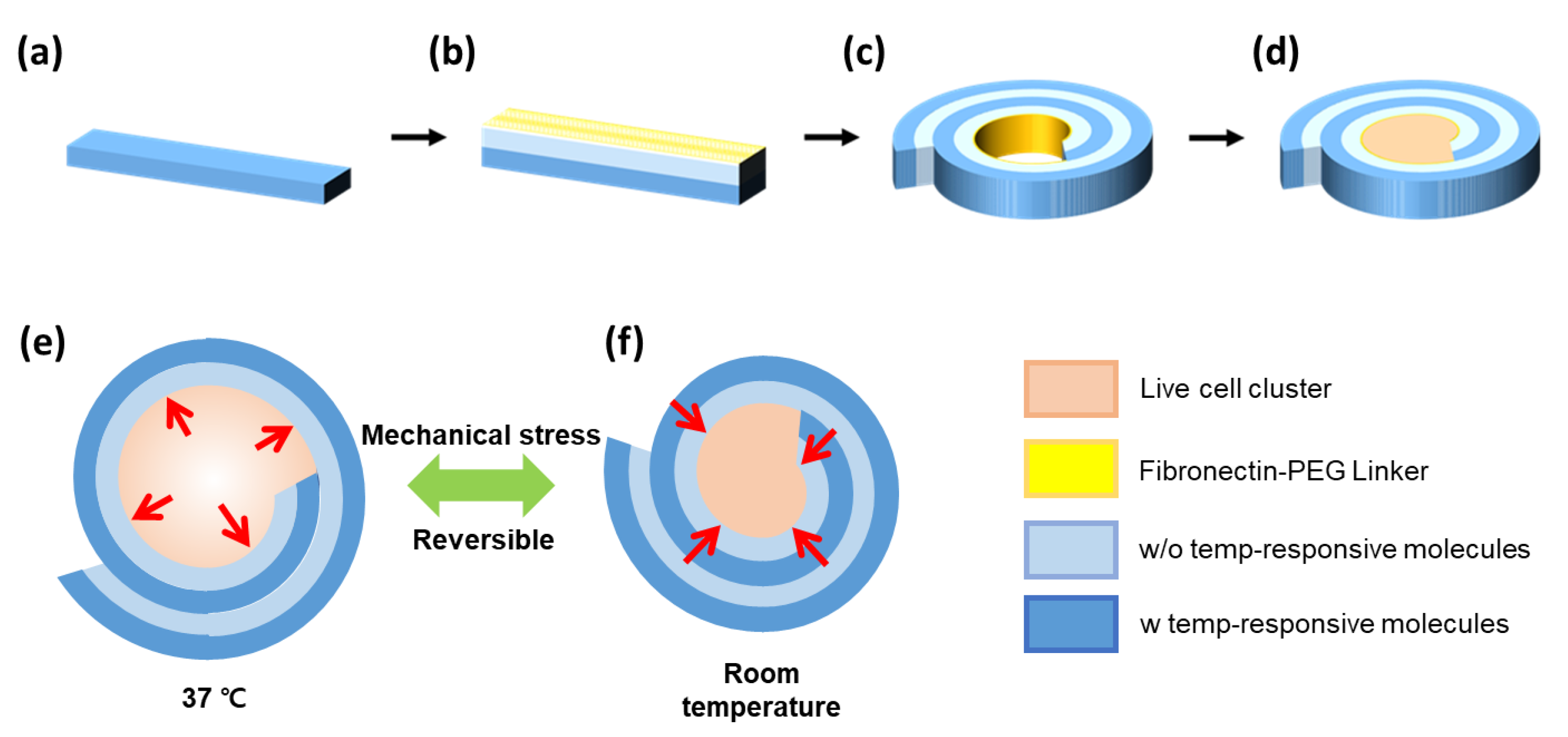
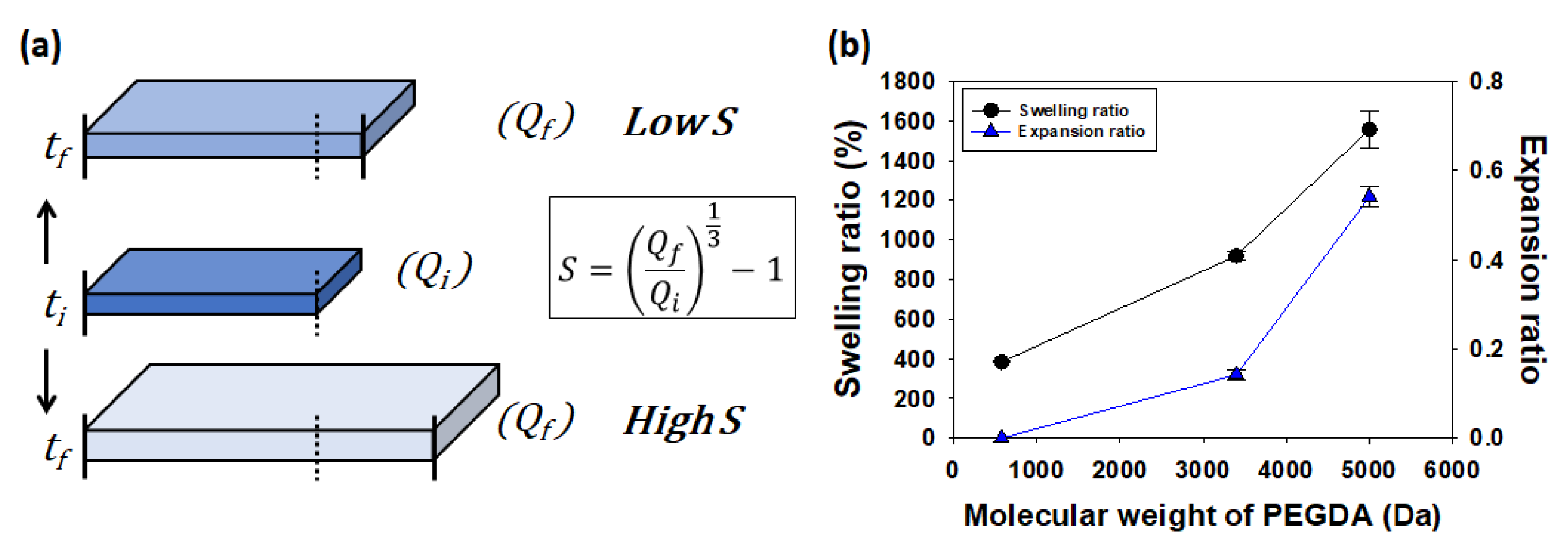
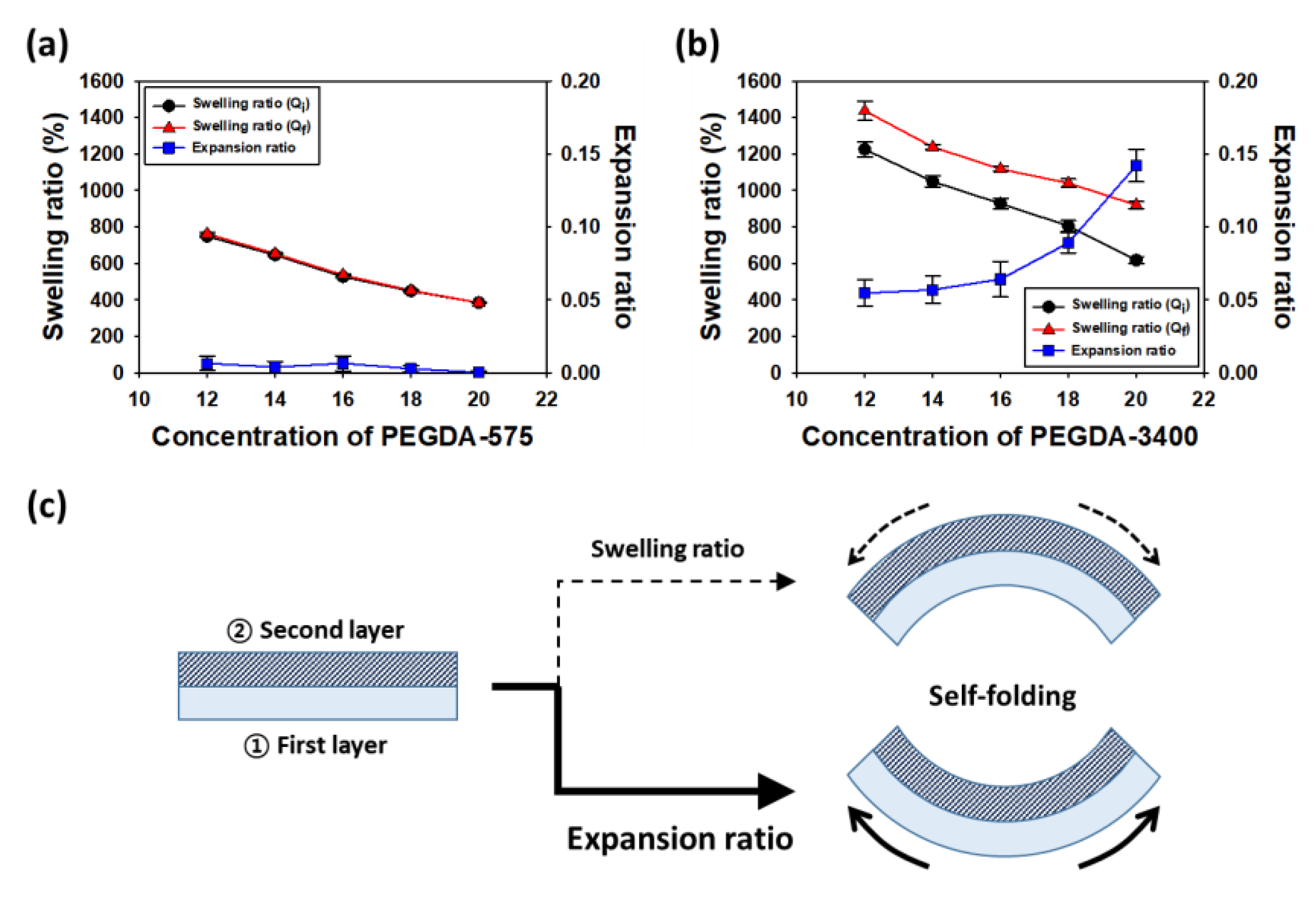
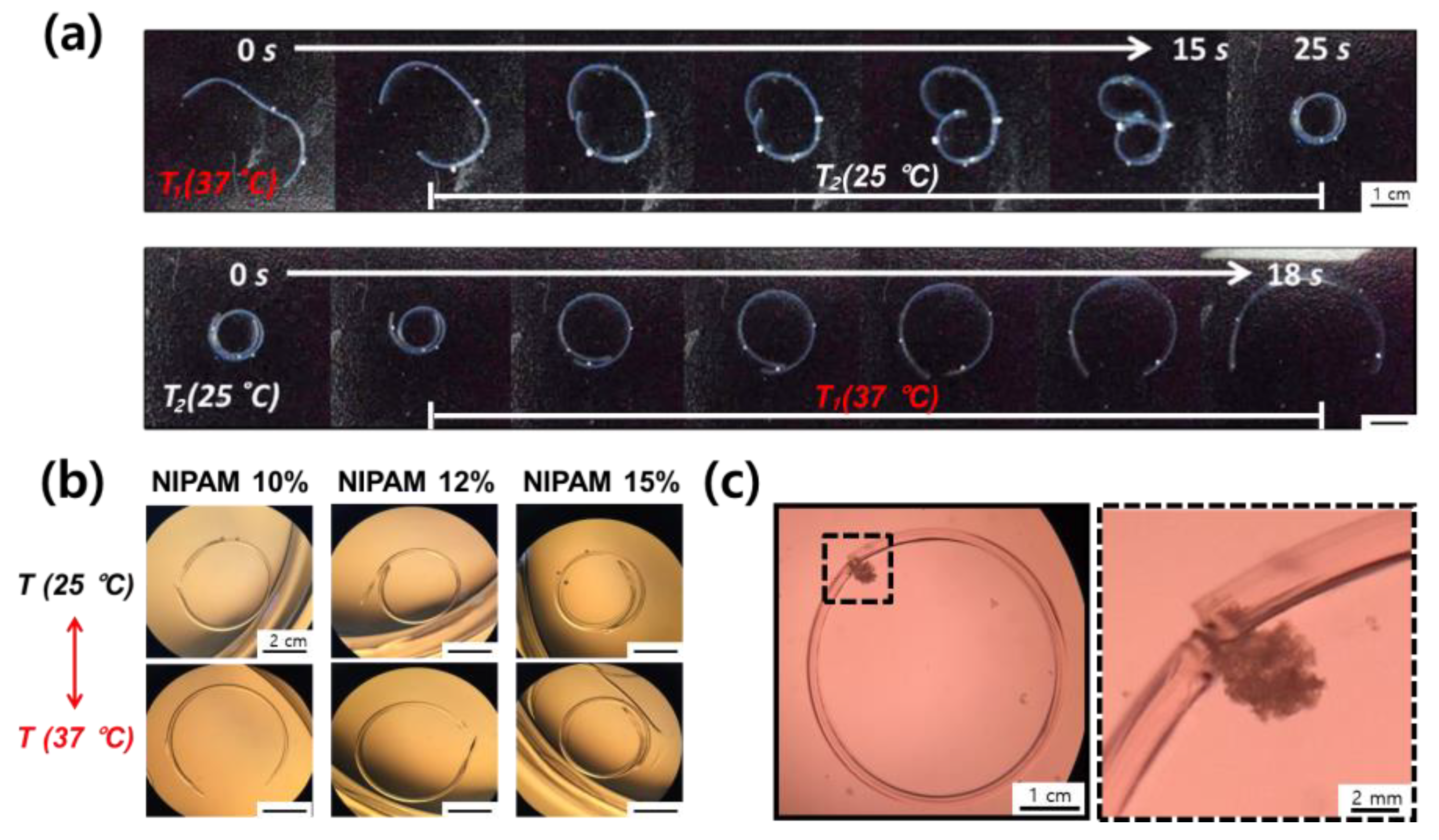
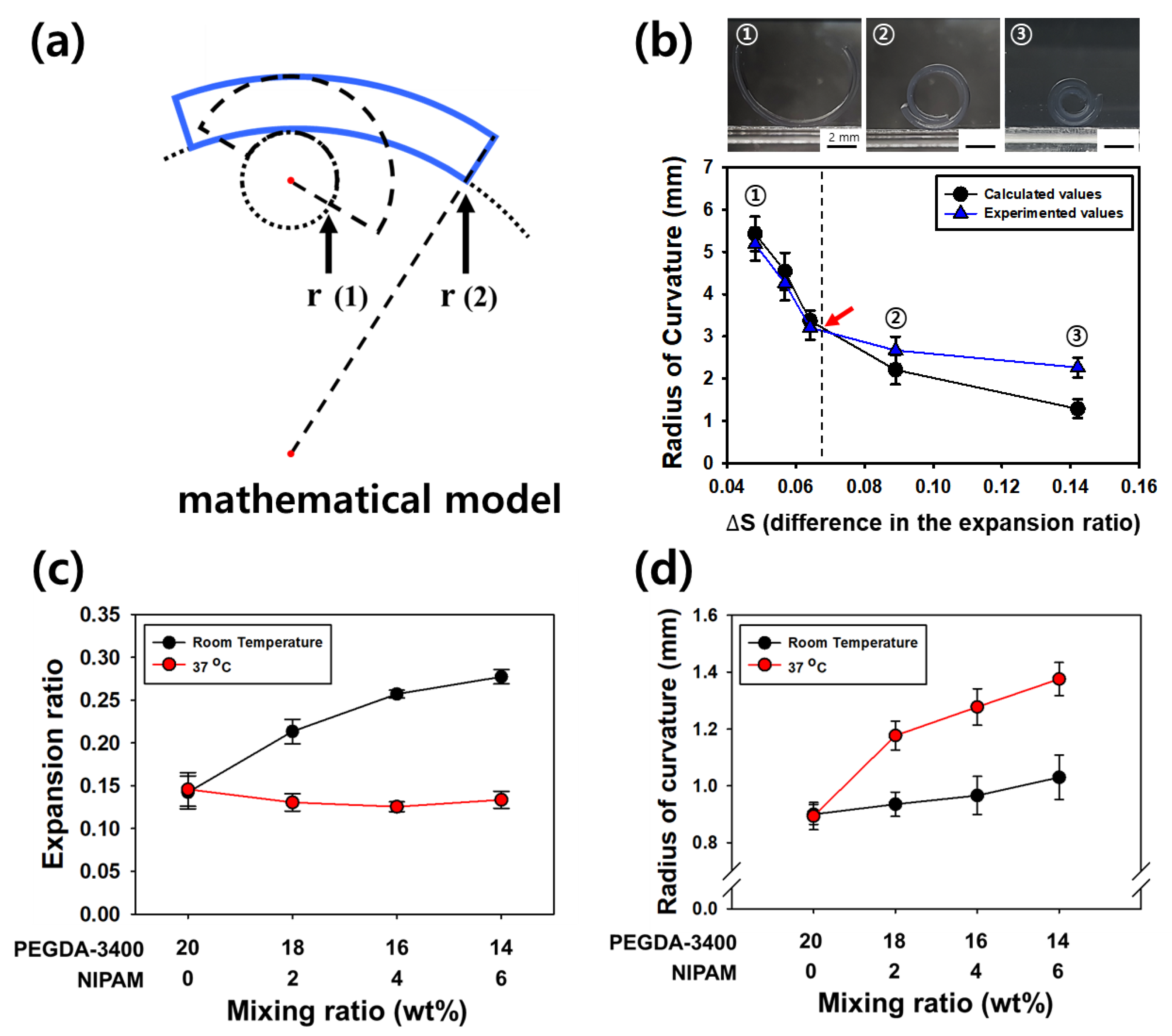
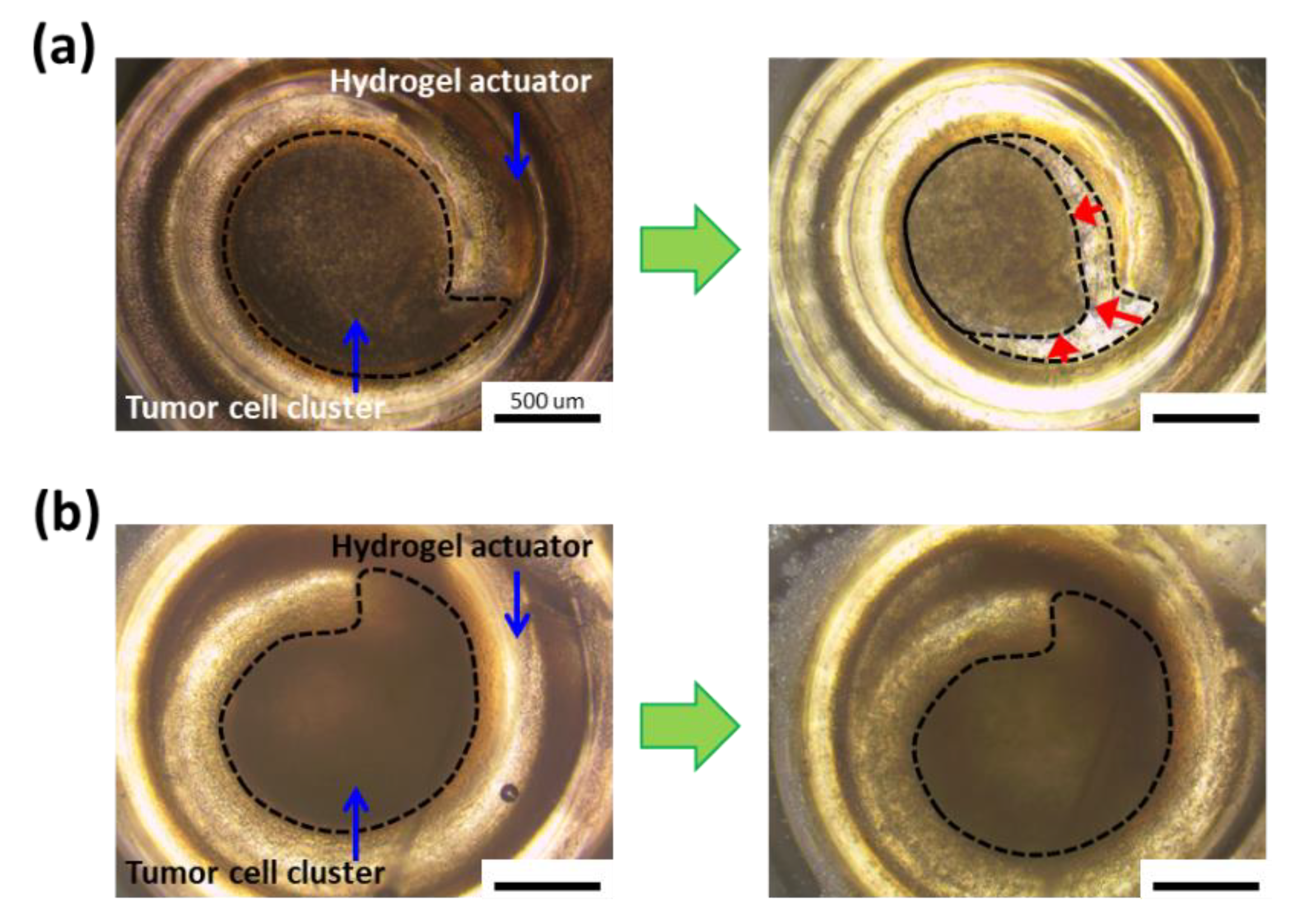

© 2020 by the authors. Licensee MDPI, Basel, Switzerland. This article is an open access article distributed under the terms and conditions of the Creative Commons Attribution (CC BY) license (http://creativecommons.org/licenses/by/4.0/).
Share and Cite
Lim, J.W.; Kim, H.-j.; Kim, Y.; Shin, S.G.; Cho, S.; Jung, W.G.; Jeong, J.H. An Active and Soft Hydrogel Actuator to Stimulate Live Cell Clusters by Self-folding. Polymers 2020, 12, 583. https://doi.org/10.3390/polym12030583
Lim JW, Kim H-j, Kim Y, Shin SG, Cho S, Jung WG, Jeong JH. An Active and Soft Hydrogel Actuator to Stimulate Live Cell Clusters by Self-folding. Polymers. 2020; 12(3):583. https://doi.org/10.3390/polym12030583
Chicago/Turabian StyleLim, Jun Woo, Hee-jin Kim, Yechan Kim, Sung Gyu Shin, Sungwoo Cho, Woong Gyu Jung, and Jae Hyun Jeong. 2020. "An Active and Soft Hydrogel Actuator to Stimulate Live Cell Clusters by Self-folding" Polymers 12, no. 3: 583. https://doi.org/10.3390/polym12030583
APA StyleLim, J. W., Kim, H.-j., Kim, Y., Shin, S. G., Cho, S., Jung, W. G., & Jeong, J. H. (2020). An Active and Soft Hydrogel Actuator to Stimulate Live Cell Clusters by Self-folding. Polymers, 12(3), 583. https://doi.org/10.3390/polym12030583





